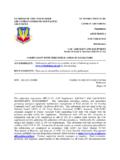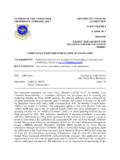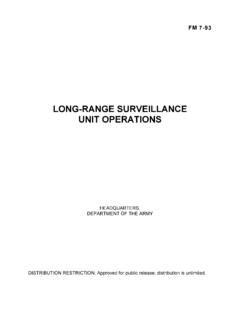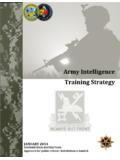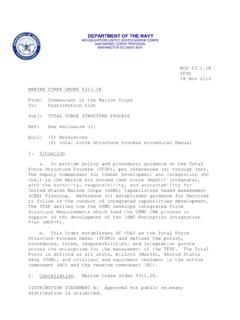Transcription of U.S. Joint Forces Command JECC
1 Volume 4 Issue 4 May 2011 Personnel from the Joint Enabling Capabilities Command ( jecc ) attend the Joint Enabling Capabilities Planners Course (JEC PC) to become more familiar with the Joint operation planning process. Pictured above, JEC PC students discuss possible courses of action as they work through a complex humanitarian assistance scenario to reinforce the lessons taught by the jecc facilitators. Photo by USJFCOM Joint Enabling Capabilities CommandJulianne SympsonUSJFCOM JECCT he Joint Forces Command s (USJFCOM) Joint Enabling Capabilities Command ( jecc ) routinely deploys teams of highly skilled Joint planners from its Joint Deployable Team (JDT) to provide expertise in the functional areas of operations, plans, logistics and information superiority / knowledge management during crisis and contingency operations worldwide. Prior to executing real-world mis-sions, the jecc JDT members partici-pate in a variety of training activities to enhance their operational planning skill sets.
2 The jecc maintains an employability matrix that tracks these training activities and correspondingly gauges the individual skill levels of each JDT member to ensure they can efficiently and effectively support the Joint force commander s (JFC) of the most significant items tracked on the employability matrix are the JDT members completion of the jecc -led Joint Enabling Capabilities The jecc deploys highly trained JDT members continued on page Commander s MessageWelcome to the May issue of the Joint Forces Command (USJFCOM) Joint Enabling Capabilities Command ( jecc ) newsletter. As we prepare for the second half of the year, the jecc is focused on the development of Joint expertise that members sustain to contribute to the rapid establishment of a Joint task force headquarters (JTF HQ) and our reassignment to Transportation Command on July 1, 2011.
3 The jecc is committed to deploying the most qualified teams to fill Joint force commander requirements and ensures this process by tracking individual development and training of the necessary skill sets to efficiently and effectively establish, organize and operate a JTF HQ. To read more on how the jecc trains and qualifies its members see the article included on the front page. Correspondingly, the jecc s Joint Communications Support Element (JCSE) has been making strides to further educate and train their members on the latest innovations in communications equipment and gear. They recently completed construction of a state-of-the-art Squadron Operations Facility and held an official ceremony in March. Further details on the advanced capabilities that this new building brings to JCSE are provided on page 3. The jecc s continual training to improve and sustain unique skill sets allows members to maintain an alert-posture and respond to emerging real-world missions on short notice.
4 In March 2011, the jecc rapidly deployed 53 planners and operators from the JDT, the JCSE and the Joint Public Affairs Support Element (JPASE) in support of the response following the magnitude earthquake and tsunami in Japan. JPASE and JDT members provided public affairs and advanced Joint planning expertise to the military assisted departure mission during Operation Pacific Passage. In addition, JCSE members supplied communications infrastructure and equipment to the humanitarian assistance mission during Operation Tomodachi. For more information on the support the jecc provided to these two concurrent operations see page 5. An additional article is also included on page 5 which focuses on JCSE s employment of the Deployable Joint Command and Control system at Yokota Air Base, Japan. Also included on page 6, two JCSE members recently deployed to support an evacuation of the Embassy staff in the Ivory Coast.
5 The jecc is committed to providing high quality, timely and professional Joint capabilities as we continue to enhance the employability of our personnel. This has been an exciting year so far and we are looking forward to supporting the Joint warfighter in the hope you enjoy the latest issue of the jecc newsletter and thank you for your continued support and interest in the Command . All the best, W. E. CarterRear Adm., Navy Commander, Joint Enabling Capabilities Command Joint Forces CommandThe jecc responds to Japan relief efforts. Page 5 Joint ENABLING CAPABILITIES Command NEWSLETTERJECCThe jecc deploys highly trained JDT members to support the Joint warfighterJCSE squadrons move into a new state-of-the-art building. Page 3 USJFCOM Joint Enabling Capabilities Command Contact: 4, Issue 4 Volume 4, Issue 4 Page 2 The jecc deploys highly trained JDT members continued from page Course (JEC PC) and participa-tion in geographic combatant Command (GCC)-sponsored exercises.
6 Upon arrival at the jecc from their previous service-specific units, the JDT members are immediately enrolled in the JEC PC, an in-house course offered quar-terly that introduces the Joint operation planning process (JOPP) to new mem-bers who may have limited or no Joint planning experience. This course provides an overview of Joint task force (JTF) operations and provides a better understanding of how strategic guidance can shape planning in the initial establishment of a JTF at the operational level. In addition, the course stresses the importance of incorporating all key stakeholders in accomplishing the mission. The JEC PC is grounded in Joint doctrine and allows participants to actively apply the JOPP during a realis-tic scenario which creates an authentic training experience. During the 10-day course, the first half is focused on introductory material and the initial steps of the JOPP that are executed during mission analysis.
7 Following these instructional sessions, the students develop and select courses of action as they work through a complex humanitarian assistance scenario which enhances the learning process. The JEC PC offers students the op-portunity to build mission analysis and decision briefings that they then present to the designated JFC for the course. As the students work through the scenario they become more aware of the challeng-es associated with crisis action planning and how to lead and participate in Joint planning group and operational planning team sessions. The students collabora-tion during these sessions integrates the planning efforts across the JTF. By the end of the course, the students produce a coordinated and synchronized product that would enable the JFC to make the necessary decisions in the newly estab-lished JEC PC provides potential JTF members an opportunity to work togeth-er and provides the students with the necessary knowledge they would need to be value-added members during Joint planning at the operational level.
8 JDT member, Navy Cmdr. Charles Smith, explained the value of the JEC PC to better prepare JDT mem-bers before deploying downrange. The JEC PC prepares us to execute the Joint operation planning process which is the core of the expertise the jecc provides Joint force commanders when deployed, said Smith. We are already familiar with course of action de-velopment, analysis and synchronization which enables us to bring an expertise that may not already be resident in the JTF staff. Upon completion of the JEC PC, JDT members participate in GCC-led exercis-es to reinforce the lessons learned during the JEC PC and further enhance their understanding of the JOPP. Most recently, nine JDT members participated in Pacific Command (USPACOM) / Combined Forces Com-mand / Forces Korea (USFK) exercise, Key Resolve 2011 (KR11) from Feb. 22 March 10, 2011. This exercise is held annually to strengthen the alli-ance between the Republic of Korea and the and their ability to protect the region.
9 During KR11, JDT personnel served in key staff positions for Eighth Army (EUSA), a service component headquarters of USFK, one of USPA-COM s sub-unified commands. JDT members assisted EUSA, which was designated as an operational headquar-ters during the exercise, in meeting its training objectives and provided the unit a better understanding of the level of support the jecc can provide. GCC-sponsored exercises give JDT members an opportunity to gain critical insight to various Command staffs during the planning process and to develop op-erating relationships. Air Force Col. Paul Eberhart, the former jecc JDT Director, commented on the expertise the jecc provides to training exercises and the experience the JDT gains from work-ing with other commands. During operational planning, the staff we are supporting may not be familiar with all of the planning phases necessary during a Joint operation, ex-plained Eberhart.
10 JDT members bring an understanding of the Joint operation planning process and strategic think-ing to an operational headquarters that provides a valuable Joint perspective of the mission at hand. The jecc deploys highly trained JDT members to support the Joint warfighterA Republic of Korea Forces air simulation specialist, Staff Sgt. Hwang Song Hun (right), works with Air Force Staff Sgts. Muneerah Williams and Michael Rowe, Air Force air operators from Kunsan Air Base (left and center), during exercise Key Resolve at Osan Air Base, South Korea. From Feb. 22 - March 10, 2011, the Joint Enabling Capabilities Command s ( jecc ) Joint Deployable Team provided nine Joint planners to support Eighth Army in their role as the operational headquarters during the exercise. Photo by Air Force Tech. Sgt. Matthew McGovern JDT members bring an understanding of the Joint operation planning process and strategic thinking to an operational headquarters that provides a valuable Joint perspective of the mission at hand.

